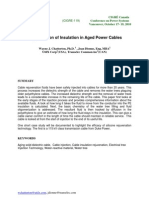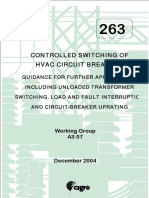Partial Discharge 1 PDF
Partial Discharge 1 PDF
Uploaded by
samsungloverCopyright:
Available Formats
Partial Discharge 1 PDF
Partial Discharge 1 PDF
Uploaded by
samsungloverOriginal Description:
Original Title
Copyright
Available Formats
Share this document
Did you find this document useful?
Is this content inappropriate?
Copyright:
Available Formats
Partial Discharge 1 PDF
Partial Discharge 1 PDF
Uploaded by
samsungloverCopyright:
Available Formats
ACHV & PD COMMISSIONING TESTING OF SOLID DIELECTRIC CABLE SYSTEMS
INTRODUCTION
Kinectrics Inc, formerly Ontario Hydro Research Division, has been servicing the Transmission and Distribution sector as well as the processes industry since its formation in 1912. For HV and EHV cables, Kinectrics provides cradle-to-grave services for manufactures, installers and utilities and have full laboratory capabilities for type testing of solid dielectric cable systems rated up to 500kV XLPE cable and for commissioning and maintenance field testing of solid dielectric cable systems rated up to o 500kV. In addition, Kinectrics has full laboratory capabilities (electrical, mechanical and chemical ) for forensic investigations. Kinectrics has been performing ACHV (High Potential Overvoltage test) and Partial Discharge testing on solid dielectric HV cable systems since the mid 1970 ties. Kinectrics has been performing AC HiPot & conventional PD field testing of HV cable systems since the mid 1960ties and started performing broadband field PD measurements (non conventional) on cable systems in the late 1970 ties. Kinectrics continues to innovate and contribute to the industry via participation in in various domestic and international committees related to multiple aspects of cable testing. Also, Kinectrics continue to spend resources on research and development within various aspects on MV, HV and EHV cable systems. AC HV & PD Commissioning testing helps find installation related life limiting defects in new cable systems prior to energization. Thus, in-service failures can be avoided and/or drastically reduced. The test methodology described in the following constitutes a proven test method for assessing the quality of a newly installed cable system. The methodology is well adhered to in regions such as North America, Europe and the Middle East. In the following, the two different components, namely AC HV and PD testing, are described.
ACHV/HIPOT TESTING
TEST METHODOLOGY
The purpose of an withstand (over voltage) test is to apply a sufficiently high voltage for a sufficiently long period of time to cause a defect to result in insulation failure via partial discharge activity. The cable system is said to have passed the test if no failure occurs. No standards exist for VLF AC withstand testing of HV & EHV solid dielectric cables. However, standards for near power frequency withstand testing of HV & EHV cable systems. Specifically, such tests are performed to IEC standards 60840 for cables rated 30kV to 150kV and to 62067 for cables rated 150kV to 500kV. Test levels for various ratings of cables are stipulated in the standards. Typically, cables are tested at levels ranging from 1.5U0 to 2U0 continuously for 60 minutes. The test voltage applied should be sinusoidal and have a frequency ranging from 20 Hz to 300 Hz. The frequency range is often referred to as near power frequency. AC HiPot testing provides for realistic electrical stresses internal to cable sections, joints and terminations. By performing field testing to IEC standards a direct link to the type tests performed in the factory is established. It should be noted that for HV cables such as these, near power frequency AC HiPot & PD commissioning testing is primarily performed to access the quality of the installation of joints and terminations. It should be noted, VLF testing is not applicable as an alternative for commissioning testing for HV & EHV cable systems. VLF testing does not provide electrical stresses similar to those experienced in service. As well, by its very nature, VLF testing is not able to detect any insulated related defects requiring dielectric heating to occur (interfacial issues, impurities etc). Furthermore, when testing at VLF conditions, the voltage test level must be significantly increased to achieve similar results to those obtained at AC conditions (see the graph below). For instance, as can be seen from the graph below, the test level at VLF conditions must be 2 to 2.5 time higher that at AC to achieve similar results. Therefore,
for instance 138kV XLPE insulated cable typically tested at 136kVac.RMS should be tested at approximately 272kVVLF.RMS or higher to achieve similar results.
Figure 1: Measured break-down voltages for cable samples containing artificial defects as a function of test voltage frequency.
In addition, there is strong experimental evidence that the number of cycles applied to a solid dielectric cable system is important and, that for most cable defects, several thousands of cycles are often needed to cause failure or PD around life limiting defects. As well, for some defects, local thermo-mechanical losses are needed to ignite PD and these, from a practical point of view, only occur at near power frequency. Therefore, from a practical point of view, with existing available knowledge and existing available equipment performing VLF AC withstand test which has similar reliability in terms of detecting life limiting defects for new cables systems is not feasible.
TEST EQUIPMENT
The power supply used for these tests is a variable frequency resonant test set manufactured by High Volt in Dresden, Germany. The RTS test set is rated 260kV at 83 Amps and is capable of energizing up to ~8 miles of 230kV cable. The test set is kept under valid calibration. A schematic of the RTS is given in Figure 2 and an equivalent circuit is given in Figure 3. Multiple RTS units can be configured in parallel configuration to achieve higher test current capabilities or in serial configuration to achieve higher test voltage capability or in serial-parallel configuration to achieve both higher current and test voltage capabilities. Kinectrics has performed a commissioning test of a 15kM 400kV XLPE insulated cable system located in the Middle East for which six (6) RTS unit test units configured in a series-parallel configuration thus creating a test system capable of 520 kV at 249 Amp. As can be seen from Figure 2, the test trailer has three axes. The trailer weighs approximately 46 metric tonnes (without the tractor unit) and has a length, width and height of 40 8 13 (12m 2.5m 4m). A foot print of 40 20 (12m 6 m) is required for setting up the high voltage test set. Typically, substations with HS-20 loading will be sufficient for supporting the weight of the RTS trailer.
Control room (A/C) Control and feeding unit HV reactor
Truck with trailer
Exciting transformer
Figure 2: Sketch of RTS Trailer
HV filter and protection unit
Figure 3 shows a schematic of the test setup with a 260kV, 83 Amp RTS unit. The resonant test set consists of a control and feeding unit, a step-up transformer (excitation transformer) and the main reactor. The main reactor is rated 260kV, 83 Amps, 21850 kVA and has an inductance of 16 H. The excitation transformer is rated 550V/950V - 1800V - 2650V - 3050V, 400Amp/83 Amp- 83 Amp - 83 Amp - 72.5 Amp and 220kVA. The test set is fed by a three-phase 400 volt, 125kVA diesel generator. In the Control and Feeding Unit, the three phase voltages are converted into a single phase DC voltage which, via an IGBT circuit, is converted into a pulse width modulated square wave feeding the excitation transformer (step-up transformer) for the main reactor. As can be seen from Figure 3, the test setup constitutes an L-R-C circuit. Thus, resonance occurs at the frequency for which the capacitive and inductive current components are balanced and only the resistive losses of the system are supplied. As can be seen from Figure 3, a blocking impedance is placed between the power supply and the high voltage connection to the cable under test. The purpose of the blocking impedance is twofold: First, the blocking impedance protects the RTS in the unlikely event of a cable failure and, second, the blocking impedance effectively filters any high frequency noise originating from the RTS itself thus improving the signal-to-noise ratio for any PD measurements. Also, as can be seen, a capacitive voltage divider provides for a voltage reference for the control unit of the power supply. As mentioned earlier, the capacitive voltage divider is kept under valid calibration. Via the capacitive voltage divider, the voltage applied to the cable is measured every second and a profile of the actual test voltage applied is logged and stored for reporting purposes.
Figure 3: Schematic of RTS Test Setup
A photo of an RTS test setup is shown in Figure 4. As can be seen, the RTS is connected to the cable termination via a partial discharge free custom made test bus; a current carrying copper wire connects the output of the RTS to the test bushing whereas flexible aluminum tubing provides for electrical screening thus suppressing any external corona. Also, if necessary, corona rings may be placed on the cable termination itself.
Figure 4: Photo of test connections
PARTIAL DISCHARGE TESTING
INTRODUCTION
Partial Discharge testing will help identify faulty spots within cable terminations, cable joints (splices) as well as within the cable insulation it self. For longer lengths of transmission class cable, due to well known and well documented issues with signal deterioration primarily due to attenuation and secondary due to reflection/transmission at impedance mismatches at joint/cable section interfaces, in order to assess the insulation condition via PD measurements, these must be performed at different points along the cable routing. In other words, a distributed partial discharge measurement is required and to ensure optimal sensitivity PD measurements should be performed at each accessory. The primary frequency content of partial discharge sources depends on the nature of the source and its location. Thus, for a PD measurement on any equipment, a wide range of partial discharge frequencies can be expected. To ensure than any given PD source is measured at any given point in time, high frequency broadband partial discharge technology should be used. Furthermore, it is well understood theoretically and experimentally that PD activity from any given PD source (insulation issue) can be erratic or periodic in nature and not necessarily be constantly present even when testing above the initial PD inception voltage. Consequently, for a PD test to be most effective, all accessories should be monitored continuously through the AC HiPot test. For PD measurements on transmission class cable system (and longer lengths of distribution class cable), ultra broadband partial discharge monitors are used in conjunction with pre-installed sensors. These monitors typically allow for broadband detection of PD signals thus preserving as much of the original PD pulse shape as possible. Like conventional PD systems, for each signal detected, a magnitude and a phase angle is measured and stored thus allowing for the creation of conventional PD Pulse Height Analysis and Pulse Phase Analysis plots. In addition, unlike conventional PD monitors, these technologies acquire and store the actual pulse shape of each signal measured. This allows for both frequency and time-domain analysis. This in turn allows for not only separation of PD signals from noise signals but also for separation of PD signals originating from different locations with in the insulation of the cable it self, the termination or the joints. The test method is non-invasive and intrinsically safe.
PD TEST METHOD
For cable systems where integrated (embedded) sensors are not available external inductive or capacitive sensors can be used. When using the former approach, a split-core High Frequency Current Transformer (HFCT) is placed around the bonding cable to each joint of each phase and, thus, high frequency current signals originating from PD activity within the cable insulation or within cable accessories may be detected and measured. When using the latter approach, a custom made capacitive sheath sensor is placed on the jacket as close to the joint as possible. The custom made sensor is designed such to provide a proper frequency response. Both signal coupling methods are safe and can be performed during normal operations without an outage. The coupling method for the inductive HFCT sensors is as follows: In the case of partial discharge activity in a cable accessory, high frequency currents will be induced both on the high voltage conductor and on the grounded conductor. These will flow towards the nearest ground. Consequently, these will flow through the bonding cables. By placing an HFCT with appropriate frequency response around the bonding cable, induced partial discharge currents may be measured via the electro-magnetic coupling between the bonding cable and the HFCT. The current induced in the HFCT may be measured via an oscilloscope or a partial discharge monitor.
The coupling method for the capacitive sheath sensors is as follows: In the case of partial discharge activity in a cable accessory, high frequency currents will be induced both on the high voltage conductor and on the grounded conductor. These will flow towards the nearest ground. Consequently, these will flow through the cable sheath. By placing a sheath sensor with appropriate frequency response on the jacket of the cable, induced partial discharge currents may be measured via the capacitive coupling between the sheath and the sensor it self and these may be measured via an oscilloscope or a partial discharge monitor. It should be noted the signal measured and stored will be a voltage signal as the input impedance of any oscilloscope or PD monitor is predominately resistive. For a further introduction to PD sensors and their functionality please refer to Cigre 182 Partial Discharge Detection in Installed HV Extruded Cable systems. A further discussion on the coupling method for the capacitive partial discharge sensors is beyond the scope of this appendix. To optimize the Signal to Noise (S/N) Ratio, Sheath Voltage Limiters (SVLs) should be removed or shorted out during the AC HiPot & PD Tests. The partial discharge monitors used for this project are manufactured by IPEC Inc and have four input channels of which only two are typically used for these tests. The monitor has a true analog bandwidth of 400 MHz with a frequency response from DC to 400MHz and a maximum digital sampling rate of 5 GS/s. For most acquisition modes, the IPEC is set with a lower frequency cut-off of 100kHz. The minimum dead time between triggers depends on the frequency at which the tests are conducted. The worst-case scenario (longest dead-time) between triggers would be for a test frequency of 20Hz for which the deadtime between triggers is 25S. Partial Discharge Assessment Methodology For the partial discharge analysis, four plots produced by the IPEC technology are used for the data assessment: 1. 2. 3. 4. Pulse Height Analysis Plot (PHA Plot) Pulse Phase Analysis Plot (PPA Plot) Classification Map (TW Plot) Waveform Plot
The PHA and PPA plots are produced in accordance with IEEE Std. 1434. The Pulse Height Analysis plot displays the distribution of pulse magnitudes as a function of repetition rate. The Pulse Phase Analysis plot shows the distribution of pulse magnitudes as a function of phase angle. In conjunction with the PHA Plot, the PHA plot is used for identifying the presence of partial discharge activity as well as the type and nature of the discharge source(s) measured via PPA pattern analysis. The plots are widely used throughout the industry for interpretation of partial discharge data acquired not only on cables but also rotating machines, transformers and switch gear and allow for an over all assessment of the signal activity including whether partial discharge activity is present. For further information on the Pulse Height Analysis plot and Pulse Phase Analysis plot please refer to IEEE 1434 as well as Cigre 226 Knowledge rules for partial discharge Diagnosis in Service. The Classification Map (or TW map) displays different categories of pulses by displaying the distribution of pulse wavelengths as a function of the fundamental frequency content of each pulse acquired. The Classification Map allows for PPA plots of individual signal sources thus allowing for, detection of PD activity if present below the noise limit as evaluated by magnitudes only and pattern recognition of individual PD sources. The waveform plot allows display of each individual waveform detected and stored and is thus used for signal analysis of individual waveforms. Thus, analysis of partial discharge data acquired on field-installed cable systems is not a fail or pass assessment with respect to a reference PD magnitude level. Rather, analysis of partial discharge data is
a complex field and requires in-depth theoretical knowledge on material science as well as in-depth knowledge on several disciplines of electrical engineering: Dielectric science and in particular the dielectric insulation system tested Electro-magnetic field theory Signal coupling Digital signal detection and processing as well as signal storage. Lastly, background noise levels depend on the ambient noise environment as well as local grounding conditions. Thus, background noise levels vary from test location to test location but may also vary at a given test location over time. However, using broadband partial discharge systems capable of acquiring and storing individual signal shapes (waveforms) circumvents the issue of being limited to detecting partial discharge activity above the noise level as evaluated by a magnitude level only. Specifically, for broadband partial discharge systems such as these used here, partial discharge activity having magnitudes less than the background noise will be detected providing the signal shapes of the background noise is different from that of PD. Consequently, for locations having high background noise levels partial discharge activity if present can still be detected.
You might also like
- Relative Humidity Homework WorksheetDocument3 pagesRelative Humidity Homework Worksheetmelanie50% (2)
- The Technology of Instrument Transformers: Current and Voltage Measurement and Insulation SystemsFrom EverandThe Technology of Instrument Transformers: Current and Voltage Measurement and Insulation SystemsNo ratings yet
- Megger Test Procedure Explained With Transformer ExampleDocument4 pagesMegger Test Procedure Explained With Transformer ExamplesamsungloverNo ratings yet
- Cigre Tf21-05id44ver24Document10 pagesCigre Tf21-05id44ver24salekojic5332No ratings yet
- 13-Mike Engelbrecht - Methods of Maintenance On High Voltage Fluid FilledDocument5 pages13-Mike Engelbrecht - Methods of Maintenance On High Voltage Fluid FilledRomany AllamNo ratings yet
- OilFilledPowerCable Catalog PDFDocument24 pagesOilFilledPowerCable Catalog PDFsamsungloverNo ratings yet
- Eng Class IIIDocument26 pagesEng Class IIIsamsunglover100% (1)
- Work Method Statement For 132kV Cable PullingDocument1 pageWork Method Statement For 132kV Cable PullingsamsungloverNo ratings yet
- Wallis Catalogue - Earthing SystemDocument120 pagesWallis Catalogue - Earthing Systemjk_173No ratings yet
- Compair Hydrovane Hv30-45Document34 pagesCompair Hydrovane Hv30-45steve@air-innovations.co.zaNo ratings yet
- PD Measurement For HV Cable SystemDocument7 pagesPD Measurement For HV Cable SystemMichael Parohinog GregasNo ratings yet
- Cigre 2010 - On-Site Commissioning Test and Diagnostics ofDocument7 pagesCigre 2010 - On-Site Commissioning Test and Diagnostics ofAnonymous F71F47EnKNo ratings yet
- Technical Implementation of Cross Bonding On Underground High Voltage Lines Projects (Sobral2011) PDFDocument4 pagesTechnical Implementation of Cross Bonding On Underground High Voltage Lines Projects (Sobral2011) PDFdaegerteNo ratings yet
- Hotspot Location and Mitigation For Underground Power CablesDocument5 pagesHotspot Location and Mitigation For Underground Power CablesCarlos LiceaNo ratings yet
- Article On Screen GroundingDocument6 pagesArticle On Screen GroundingdivyangkumarNo ratings yet
- Section Four - Medium Voltage Tr-Xlpe Cables: Explanatory Information 2-13Document56 pagesSection Four - Medium Voltage Tr-Xlpe Cables: Explanatory Information 2-13Terex14253No ratings yet
- HV DC PrysmianDocument32 pagesHV DC PrysmianFiras AtwanNo ratings yet
- VLF FaqDocument4 pagesVLF Faqminhduc ngoNo ratings yet
- CigreDocument11 pagesCigreAlfan Farizki HarahapNo ratings yet
- Points To Consider Regarding The Insulation Coordination of GIS Substations With Cable Connections To Overhead LinesDocument5 pagesPoints To Consider Regarding The Insulation Coordination of GIS Substations With Cable Connections To Overhead Linesmoh_essamoNo ratings yet
- Identification of Problems When Using Long High VoDocument8 pagesIdentification of Problems When Using Long High VoMichael KnopNo ratings yet
- TOR-WG+B1 38+After+laying+tests+on+AC+and+DC+cable+systems+with+new+technologiesDocument2 pagesTOR-WG+B1 38+After+laying+tests+on+AC+and+DC+cable+systems+with+new+technologiesWalter CataldoNo ratings yet
- digiPHONE UG enDocument31 pagesdigiPHONE UG enHadi TNo ratings yet
- The New 525 KV Extruded HVDC Cable System White PaperfinalDocument8 pagesThe New 525 KV Extruded HVDC Cable System White PaperfinalFari PratomosiwiNo ratings yet
- An Overview of Aging Mechanisms and Diagnostics For Extruded Power CablesDocument6 pagesAn Overview of Aging Mechanisms and Diagnostics For Extruded Power CableschethanNo ratings yet
- Man VLF Sin 45 enDocument51 pagesMan VLF Sin 45 enluis trujilloNo ratings yet
- G02 Manual V1.7 ENDocument19 pagesG02 Manual V1.7 ENGualadrakeNo ratings yet
- Thermal Time Const - M.Farrag - UPEC2018 - PaperDocument7 pagesThermal Time Const - M.Farrag - UPEC2018 - PaperIvenNo ratings yet
- Resistivity Testing of SubstationDocument17 pagesResistivity Testing of SubstationBernard Kipng'enoNo ratings yet
- On-Site Testing of GIS With Ac VoltageDocument6 pagesOn-Site Testing of GIS With Ac VoltagesabahabeebNo ratings yet
- b1-108 - Underground of LondonDocument8 pagesb1-108 - Underground of LondonLuisa De CairesNo ratings yet
- A Theoretical Model For Corrosion Assessment in Overhead Line ConductorsDocument6 pagesA Theoretical Model For Corrosion Assessment in Overhead Line Conductorsdeathjester1No ratings yet
- HV Routine Test Fields For Extruded Power Cables Product Brochure 9.21 5 enDocument4 pagesHV Routine Test Fields For Extruded Power Cables Product Brochure 9.21 5 enkingyenzaNo ratings yet
- Efficient Method To Accelerate Resistance Measurement of Transformer LV WindingDocument8 pagesEfficient Method To Accelerate Resistance Measurement of Transformer LV WindingbcqbaoNo ratings yet
- Partial Discharge Patterns in High Voltage InsulationDocument7 pagesPartial Discharge Patterns in High Voltage Insulationfery zenNo ratings yet
- 29 - Kim PD Measure and Monitoring On HV Cables PDFDocument4 pages29 - Kim PD Measure and Monitoring On HV Cables PDFbcqbaoNo ratings yet
- High Voltage Accessories of Brugg Cables - enDocument65 pagesHigh Voltage Accessories of Brugg Cables - enMike WazowskyNo ratings yet
- Technical Information Separable ConnectorsDocument32 pagesTechnical Information Separable Connectorsalmi yunusNo ratings yet
- Practical Application of Tan Delta Diagnostic Testing in CablesDocument7 pagesPractical Application of Tan Delta Diagnostic Testing in CablesNouman AsgharNo ratings yet
- Digital Testing of High Voltage Circuit Breaker-2Document23 pagesDigital Testing of High Voltage Circuit Breaker-2Sreevidya GopalNo ratings yet
- DTCB Brochure 31987A EN 202206 R005Document12 pagesDTCB Brochure 31987A EN 202206 R005Ingeniería SalcoNo ratings yet
- Partial Discharge Detection and Diagnosis of Transformer Bushing Based On UHF MethodDocument9 pagesPartial Discharge Detection and Diagnosis of Transformer Bushing Based On UHF MethodMuhammad Irfan NazhmiNo ratings yet
- Water Tree B54Document28 pagesWater Tree B54constellanaNo ratings yet
- Power System Technical Performance Issues Related To The Application of Long HVAC CablesDocument124 pagesPower System Technical Performance Issues Related To The Application of Long HVAC CablesFelipeSilvaNo ratings yet
- Breaker Timing - ZensolDocument20 pagesBreaker Timing - ZensolIsmail Azad100% (1)
- HV Xlpe Cables: Nigel Hampton, Application Manager - Power Cables Borealis AB, SwedenDocument34 pagesHV Xlpe Cables: Nigel Hampton, Application Manager - Power Cables Borealis AB, SwedenA. HassanNo ratings yet
- CIGRE-119 Rejuvenation of Insuslation in Aged Power CablesDocument11 pagesCIGRE-119 Rejuvenation of Insuslation in Aged Power CableskamuikNo ratings yet
- Optical Current & Voltage Sensors: Eric Langford, Langford & Associates John Swindlehurst, P.Eng, Nxtphase T&D CorpDocument38 pagesOptical Current & Voltage Sensors: Eric Langford, Langford & Associates John Swindlehurst, P.Eng, Nxtphase T&D CorpKrishna Venkataraman100% (1)
- 03 Long Rod Porcelain Insulators e 2219Document25 pages03 Long Rod Porcelain Insulators e 2219Velu SamyNo ratings yet
- Spec 46311Document2 pagesSpec 46311DI Vlad Peña PrietoNo ratings yet
- UTP MKII Product Training SlidesDocument65 pagesUTP MKII Product Training Slidesberkahharian100% (1)
- Trans Line LADocument8 pagesTrans Line LAsantoshkumarNo ratings yet
- 263 Controlled Closing of HVAC Circuit BreakerDocument56 pages263 Controlled Closing of HVAC Circuit BreakerepriNo ratings yet
- 1376 Rekaguide To Usefor52 145kvDocument26 pages1376 Rekaguide To Usefor52 145kvparthaNo ratings yet
- Polymer InsulatorsDocument34 pagesPolymer InsulatorsAbraiz Khan KhattakNo ratings yet
- 12SDMS01Document14 pages12SDMS01hafezasadNo ratings yet
- Cable Fault LocationDocument29 pagesCable Fault Locationmahmoud MotamediNo ratings yet
- 23.0 EHV XLPE Cable Rev01Document23 pages23.0 EHV XLPE Cable Rev01Ashish bhattNo ratings yet
- 500kV CablesDocument5 pages500kV CablesJaka Sembung GolokNo ratings yet
- PHD Thesis 13.11.2018 P. CicheckiDocument225 pagesPHD Thesis 13.11.2018 P. CicheckiCésar Díaz LiberonaNo ratings yet
- Partial Discharge Localization Techniques - A Review of Recent ProgressDocument31 pagesPartial Discharge Localization Techniques - A Review of Recent ProgressAM KANo ratings yet
- HVDC Circuit Breakers Report PDFDocument11 pagesHVDC Circuit Breakers Report PDFShubham patilNo ratings yet
- Ds Ac DC HV Test Set PGK 110 HB Baur En-GbDocument3 pagesDs Ac DC HV Test Set PGK 110 HB Baur En-GbRomany AllamNo ratings yet
- EDOC-Damped AC For CommissioningDocument19 pagesEDOC-Damped AC For CommissioningEl Comedor BenedictNo ratings yet
- Standard HV Test XLPE CableDocument6 pagesStandard HV Test XLPE Cableari_pras100% (1)
- VLF Testing GuidelinesDocument4 pagesVLF Testing Guidelinesnisteri100% (1)
- Class - X - 1-20Document73 pagesClass - X - 1-20samsunglover100% (1)
- 18th ED Main Changes BSI Comm 1 March 2018Document5 pages18th ED Main Changes BSI Comm 1 March 2018samsungloverNo ratings yet
- The Indian Community School, Kuwait Divided SyllabusDocument2 pagesThe Indian Community School, Kuwait Divided SyllabussamsungloverNo ratings yet
- Eng Class IVDocument51 pagesEng Class IVsamsunglover0% (1)
- Class - X - 1-20Document52 pagesClass - X - 1-20samsungloverNo ratings yet
- MEGHALAYADocument15 pagesMEGHALAYAHiteshRawalNo ratings yet
- Method Statement For Installation of Electrical DBDocument6 pagesMethod Statement For Installation of Electrical DBsamsunglover100% (1)
- Part Iv-History of The Church Lesson 21 The Early Christian ChurchDocument11 pagesPart Iv-History of The Church Lesson 21 The Early Christian ChurchsamsungloverNo ratings yet
- Method Statement For Installation of Electric PVC Conduits and AccessoriesDocument6 pagesMethod Statement For Installation of Electric PVC Conduits and AccessoriessamsungloverNo ratings yet
- This Paper Elaborates On The Various Methods of Cable Laying and The Advantages and Disadvantages of The SameDocument15 pagesThis Paper Elaborates On The Various Methods of Cable Laying and The Advantages and Disadvantages of The SamesamsungloverNo ratings yet
- Hvac Chiller Basics: Working Principle of Vapor Compression ChillerDocument2 pagesHvac Chiller Basics: Working Principle of Vapor Compression ChillersamsungloverNo ratings yet
- Basic Principles of A HVAC SystemDocument2 pagesBasic Principles of A HVAC SystemsamsungloverNo ratings yet
- Unit 2 Internet Tools: E-Mail, FTP and TelnetDocument24 pagesUnit 2 Internet Tools: E-Mail, FTP and TelnetsamsungloverNo ratings yet
- Method Statement For The Installation of Power and Lighting System WiringDocument4 pagesMethod Statement For The Installation of Power and Lighting System Wiringsamsunglover0% (1)
- Mail. 3. Show Profiles 4. Add. 5. OK. 6. Add Accounts 7. Prompt For A Profile To Be UsedDocument1 pageMail. 3. Show Profiles 4. Add. 5. OK. 6. Add Accounts 7. Prompt For A Profile To Be UsedsamsungloverNo ratings yet
- Method Statement For Installation of Electric PVC Conduits and AccessoriesDocument6 pagesMethod Statement For Installation of Electric PVC Conduits and AccessoriessamsungloverNo ratings yet
- Work Method Statement For Cable Excavation TrenchesDocument5 pagesWork Method Statement For Cable Excavation TrenchessamsungloverNo ratings yet
- Electric Quarter Turn Actuator Model HQ006 ManualDocument20 pagesElectric Quarter Turn Actuator Model HQ006 ManualsamsungloverNo ratings yet
- Vantex TMDocument25 pagesVantex TMsamsungloverNo ratings yet
- IGS-M-EL-22 (1) : ApprovedDocument10 pagesIGS-M-EL-22 (1) : ApprovedsamsungloverNo ratings yet
- Quantum ElectrodynamicsDocument10 pagesQuantum Electrodynamicsrr1819No ratings yet
- Mill Scales Calibration Schedule (Three Monthly Interval)Document10 pagesMill Scales Calibration Schedule (Three Monthly Interval)rasaqNo ratings yet
- Edexcel IGCSE Revision NotesDocument4 pagesEdexcel IGCSE Revision NotesengrroyNo ratings yet
- ETABS Model-Blockwhole24 - 02 - 2020: Level 877Document6 pagesETABS Model-Blockwhole24 - 02 - 2020: Level 877shaimenneNo ratings yet
- Iot Based Solutions For Health Care: Moving Ai To The EdgeDocument29 pagesIot Based Solutions For Health Care: Moving Ai To The EdgeJayanth R0% (1)
- Complete Download Two Trains Leave Paris Number Problems for Word People Taylor Frey PDF All ChaptersDocument50 pagesComplete Download Two Trains Leave Paris Number Problems for Word People Taylor Frey PDF All Chaptersbensibtaiko100% (3)
- Chapter 1 Introduction To ICTDocument2 pagesChapter 1 Introduction To ICTBricious MulimbiNo ratings yet
- Door - Goat - WolfDocument2 pagesDoor - Goat - WolfJojo Cansino0% (1)
- Stokes TheoremDocument16 pagesStokes Theoremvaneetg450No ratings yet
- @bohring Bot21 10 2023 SR Super60 NUCLEUS &@HeyitsyashXDDocument17 pages@bohring Bot21 10 2023 SR Super60 NUCLEUS &@HeyitsyashXDRupesh JhaNo ratings yet
- How To - Establish IPSec VPN Using Vigor Draytek ADSLDocument8 pagesHow To - Establish IPSec VPN Using Vigor Draytek ADSLthangnmNo ratings yet
- Dcu UgDocument34 pagesDcu UgSaed CattywampusNo ratings yet
- Xi MathsDocument273 pagesXi MathsNeet CrashNo ratings yet
- CHAPTER 2 Data Collection and PresentationDocument67 pagesCHAPTER 2 Data Collection and Presentationcc.jonzyruz.zaragozaNo ratings yet
- Gt-Suite: "Virtual Engine / Powertrain / Vehicle"Document0 pagesGt-Suite: "Virtual Engine / Powertrain / Vehicle"Muhidin ArifinNo ratings yet
- Cube Test ReportDocument12 pagesCube Test ReportWeei Zhee70No ratings yet
- binary numberDocument5 pagesbinary numberjitendrasingh44238No ratings yet
- 8.3.2 Prim's Algorithm PDFDocument3 pages8.3.2 Prim's Algorithm PDFMUBASHIR ALINo ratings yet
- Ups & Uvs PDFDocument14 pagesUps & Uvs PDFramkrishnaNo ratings yet
- Shs Daily Lesson in Earth ScienceDocument53 pagesShs Daily Lesson in Earth ScienceCherry Mae100% (1)
- Sample Size Requirements Reliability Studies: K and NumberDocument8 pagesSample Size Requirements Reliability Studies: K and NumberIbere DattiNo ratings yet
- Part III. Change: CH 19. Molecules in MotionDocument9 pagesPart III. Change: CH 19. Molecules in MotionDeniz KılıçNo ratings yet
- Itqmt - Midterm ReviewerDocument8 pagesItqmt - Midterm Reviewerandreajade.cawaya10No ratings yet
- Journal of Physics & AstronomyDocument12 pagesJournal of Physics & Astronomysnigdha shromaNo ratings yet
- 2013 Product Keys For AutodeskDocument5 pages2013 Product Keys For Autodesktadele kassawNo ratings yet
- XC350 Final Exam Abdullah KhalidDocument5 pagesXC350 Final Exam Abdullah KhalidShahzael MughalNo ratings yet
- Adams 2020 Adams View Command User GuideDocument2,184 pagesAdams 2020 Adams View Command User GuideManoj SinghNo ratings yet
- Chapter 16Document55 pagesChapter 16Khalil AlluhaybiNo ratings yet
















































































































